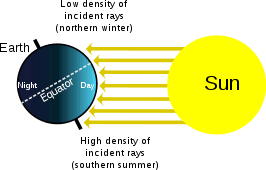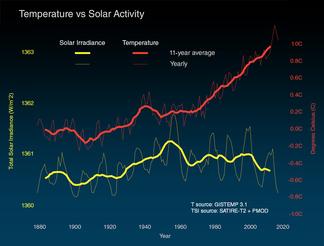Earth Sun Geometry Lab Answers
Spanish-linguistic communication version
also available »
a. Sunlight reaching World can rut the land, ocean, and atmosphere. Some of that sunlight is reflected back to space by the surface, clouds, or water ice. Much of the sunlight that reaches Earth is captivated and warms the planet.Teaching about the Sun's free energy is supported by v key concepts:
The Sun's free energy drives the climate system
The sun warms the planet, drives the hydrologic bicycle, and makes life on Earth possible. The corporeality of sunlight received on World'due south surface is affected by the reflectivity of the surface, the angle of the lord's day, the output of the sun, and the cyclic variations of Earth's orbit effectually the lord's day.
The basic science of solar energy and the role it plays for Globe's climate tin can be understood by middle school students, just the complexities of the World'south energy balance remains an area of active scientific research. Thus, this topic is both elemental and complex.
This principle is related to Free energy Literacy Principle two: Concrete processes on Earth are the result of energy menses through the Earth system.
Show students the basic mechanics of the climate system
Agreement the role of solar radiation in the Earth's climate organisation can help us grasp of import concepts such as:
The causes of the seasons.

This figure shows the tilt of Globe's axis, which causes the seasons. (Note: Distance and diameter Not to scale.)
![[reuse info]](https://cleanet.org/images/information_16.png)
Provenance: This prototype was produced past Rhcastilhos and was contributed to Wikimedia Commons. The writer of this image has released it into the public domain.
Reuse: This item is in the public domain and maybe reused freely without restriction.
The reasons water ice ages occur.
How the corporeality of free energy emitted from the sun (sun'southward luminosity) changes over time.
Why recent climate warming has not been caused by increases in the lord's day's energy output.
Near forms of energy that humans use are derived from solar energy.
Helping students sympathise these ideas

Throughout most scientific discipline education programs and standards, the role of the sun in providing free energy to the Earth system is included, simply often in a disjointed way. The seasons and their importance in driving seasonal weather patterns and animal migration may be taught in master school and and then not revisited for many years, if at all.
Moreover, students of all ages, including college students and adults, have difficulty understanding what causes the seasons. In addition to the axial tilt, factors that come into play in people's mental models include the belief that Earth orbits the sun in an elongated elliptical path; confusion most the relative size, motion, and distance of the earth from the sun; how light travels; the length of Earth'south revolution around the dominicus; and even the menstruation of rotation. One strategy to mitigate this common misconception is to ensure that the "reasons for the seasons" are adequately addressed in high school, when students accept sufficient groundwork in geometry and physics to grasp the concepts (McCaffrey & Buhr, 2008).

A persistent misconception is that our recent climate warming is due to changes in the sun's incoming energy, rather than increases of greenhouse emissions. This can be addressed by examining records of solar output and comparison them to global temperature records. The data clearly shows that the lord's day's irradiance is not correlated with Globe's temperature.
Excellent explanations for this can be establish at Skeptical Science: Dominicus and Climate: Moving in Opposite Directions and with a graphic from Bloomberg: What's Actually Warming the World? This engaging graph is made with NASA information and model output.
Bringing these ideas into your classroom
Solar radiation is the key energy driving our climate system, and nearly all climatic and biologic processes on Earth are dependent on solar input. Free energy from the sun is essential for many processes on Earth including warming of the surface, evaporation, photosynthesis and atmospheric circulation. Thus, examining how the sun fuels dissimilar processes on Earth can exist a part of many types of scientific discipline courses. Many of the science concepts relating to this principle tin can be addressed by encouraging seasonal observations, participating in denizen science programs with students (such as World), and periodically revisiting the basics of how the amount and intensity of solar energy affects Earth's climate.
The ways that the Lord's day's energy drives the climate arrangement can be taught from a very bones level on upward through the most sophisticated scientific approaches.
Integrating Solutions - The science concepts that relate to solar radiations can be expanded to include solar free energy engineering and technology, including solar ovens, passive solar pattern, solar thermal free energy and solar electricity. This can help raise awareness for alternatives to the use of fossil fuel and create a forum for discussions about solutions to climate change that our society tin can adopt.
Teaching materials from the Make clean collection

This figure shows how white ice reflects sunlight while darker ocean water absorbs sunlight. This is called albedo, or reflectivity.![[reuse info]](https://cleanet.org/images/information_16.png)
Provenance: Image Credit: NASA
Reuse: This item is in the public domain and possibly reused freely without restriction.
Middle school
- Globes and other physical models can be used to show the tilt of Earth's axis and how that affects the distribution of sunlight during dissimilar seasons, such equally in My Bending on Cooling: Furnishings of Altitude and Inclination.
- Introduction to World'due south Climate - This lesson is an introduction to Earth's climate and covers cardinal principles regarding Earth's unique climate, atmosphere, and regional and temporal climate differences.
- Feeling adventuresome? Amazing Albedo is a hands-on activity that involves measuring the temperature of different colored surfaces.
High school
- The Climate: A Balancing Act applet allows students to accommodate parameters that affect Earth'southward energy residuum: incoming solar radiation, the albedo effect, the greenhouse effect, and approachable radiation.
- Students can learn how orbital cycles and ice ages are well correlated with the Milankovitch Cycles Climate Applet.
- This Seasons Interactive visualization tool can become the ground for open-ended exploration of how solar radiations varies with location and season.
- The Solar Influence: Climate Change video from the National Academies can aid reinforce the bear witness that solar action is not causing global warming.
College
- Earth'south Heat Upkeep is a easily-on laboratory activity that investigates the furnishings of altitude and bending on the input of solar radiations, albedo, the rut capacity of land and water, and how these crusade the seasons.
- Motions of the Sunday Lab uses an blithe simulator to enable students to manipulate variables to understand the apparent motion of the sun in the sky.
- Observe changes in Earth'southward orbit that contribute to climate change - This animated visualization of Milankovitch cycles tin prepare the stage for more advanced discussion of climate forcings.
- A quantitative approach tin exist used with this step-past-pace introduction to a simple STELLA model: Modeling Earth'south Energy Balance.
- Modeling Early on Earth Climate with GEEBITT helps students become more familiar with the physical processes that made World's early climate and so dissimilar from that of today.
Find activities and visuals for didactics this topic
Search by grade level: middle school high schoolhouse intro college upper college search all grade levels
References
What's the Sunday'southward Role in Climate Change? - NASA offers an readable nonetheless authoritative await at why solar activity, solar cycles, and sunspots are not related to today's climate warming. NASA has a related mail that debunks the myth of an impending ice age.
Sun and Climate: Moving in Reverse Directions This page from the Skeptical Science website provides articulate answers to common questions and misunderstandings about climate change.
What'south Actually Warming the World? - This animated graphic compares different forcings that are acting on Globe's climate. Climatic changes acquired by orbital variation, the sun's luminosity, and volcanic emissions are compared with the upshot of greenhouse emissions. The graphic is very engaging and the data is from NASA's Goddard Institute for Space Studies (GISS).
McCaffrey & Buhr, 2008: Clarifying Climate Confusion. - Periodical article from Concrete Geography well-nigh common misconceptions in climate science.
Earth Sun Geometry Lab Answers,
Source: https://cleanet.org/clean/literacy/principle_1.html
Posted by: clearyhishowas.blogspot.com


0 Response to "Earth Sun Geometry Lab Answers"
Post a Comment